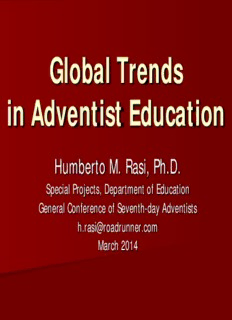
Global Trends in Adventist Education PDF
Preview Global Trends in Adventist Education
Global Trends in Adventist Education Humberto M. Rasi, Ph.D. Special Projects, Department of Education General Conference of Seventh-day Adventists [email protected] March 2014 Preliminary reflection “The Christian mind [is] a mind trained, informed, equipped to handle data of secular controversy within a framework of reference which is constructed of Christian presuppositions. The Christian mind is a prerequisite of Christian thinking. And Christian thinking is the prerequisite of Christian action. “To think secularly is to think within a frame of reference bounded by the limits of our life on earth…. To think Christianly is to accept all things with the mind as related, directly or indirectly, to man’s eternal destiny as the redeemed and chosen child of God.” Harry Blamires, The Christian Mind: How Should A Christian Think, Servant Books, 1978, pp. 43, 44 In this presentation we will… Present current statistics of our global educational system Acknowledge the leading voice that set the conceptual foundation and projected the vision of Adventist education Summarize the core characteristics of the Adventist brand of education Examine five encouraging trends and five trends that should concern us regarding the status and future of Adventist education (I am aware of the risks of this outline…) Outline 9 factors that can strengthen the identity and mission of Adventist academies, colleges and universities My perspective: Student, academy teacher and vice-principal, department chair, graduate dean, world education director, university board member, father of a college department chair/teacher, father/grandfather of students in our schools Gratitude A global phenomenon The pioneers who formally launched Adventist education in 1872 would be amazed if they could see the reach of that initiative now, 142 years later From a one-room school that met above the living quarters of the teacher—Goodloe Harper Bell—in Battle Creek, Michigan, that tentative project has become a truly global enterprise Today, on a regular school day… In 7,900 schools, academies, and colleges/universities 90,000 teachers and educational administrators Are forming the lives and future of 1.8 million students In more than 109 countries of the world A leading voice From the beginning, the leading voice in providing the conceptual foundation and projecting the vision of Adventist education was a woman who did not have extensive formal school but who was well read and aware of education– Ellen Harmon White (1827-1915) In her short essay (“Proper Education” 1872-1873), later expanded in Education (1903) and Counsels to Parents, Teachers, and Students (1913), she outlined a counter-cultural, practical philosophy and mission for Adventist education, quite ahead of her time Her counsel deals not only with elementary and secondary schools, but also with our fledgling tertiary institutions such as Battle Creek and Avondale College Challenges then and now In spite of Ellen White’s counsel, the first steps in the journey of Adventist education were uncertain The story of those challenges, ups-and-downs, and zigzags has been told by historians such as Floyd Greenleaf, George Knight, Gary Land, and others Limited human resources, perennial financial difficulties, disagreements regarding purpose, scope, and methods as well as with management and accreditation--part of that saga that continues today A century ago Frederick Griggs provided clearer curricular focus and stronger organizational structure We can thank God for His guidance: Our educational system continues to expand, although unevenly The Adventist brand of education Has a broader and deeper scope than education as commonly understood by our secular peers It seeks to form whole persons—mind, will, body, relationships It is anchored on the biblical worldview and is centered in Christ—our Creator, Savior, and Lord It fosters independent thought and positive action It prepares youth for a noble and useful life on this planet and also for life eternal with God It conveys to students the knowledge, values, skills, and attitude needed to provide quality service It forms thoughtful leaders of character for Adventist mission and for the betterment of society at large Encouraging global trends –1 1. Overall growth during recent decades in Adventist educational centers, tertiary programs, and student enrollment The expansion in general follows membership growth, but continues to lag behind proportional increase in all countries of the world For example, schools of medicine: Loma Linda, Mexico, Argentina, Nigeria, Peru… Growth occurs at a lower pace in the older Adventist centers (in a few cases, retrenchment) and a bit faster in countries where Adventism is younger and poorer Let’s examine the following charts…
Description: